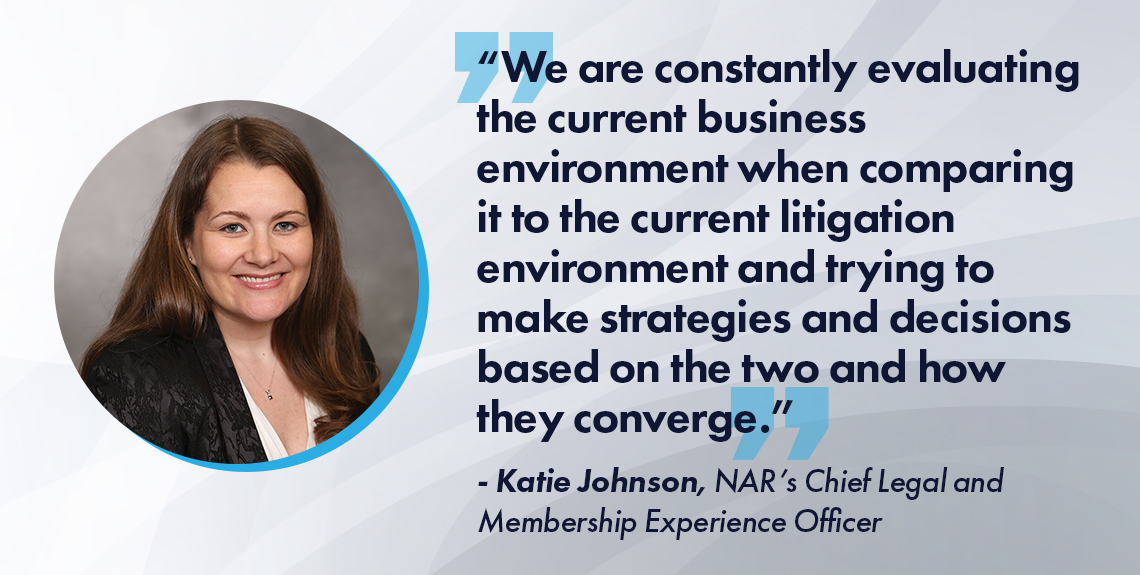It was in 2018 that the DOJ initially opened its investigation into several other allegedly anti-competitive practices by NAR, including rules that disallowed MLSs from showing consumers the buyer commission on a listing, requiring that REALTORS® put listings on NAR-affiliated MLSs, allowing buyer agents to advertise their services as “free” and limiting access to lockboxes.
In 2019, both major lawsuits (the Burnett and Moehrl cases) aimed at commissions were filed.
Why the sudden antitrust push, both from consumers and the federal government?
“There does seem to be an uptick in interest in antitrust matters,” says Ayers. “This is a very traditional kind of antitrust concern.”
Ayres denies that there is a “direct or indirect” link between the ongoing scrutiny of real estate and broader regulatory action against tech giants like Google and Amazon, which has been driven directly by a new wave of more aggressive regulators (most notably, FTC Chair Lina Khan).
Instead, he compares the current situation to a case focused on car dealerships in the 1980s, where competitors agreed not to be open on particular days. That kind of “horizontal agreement” is per se illegal, he says, even when the agreement didn’t directly affect price—just the times when consumers could shop.
That harm to consumers, and the fact that it was an agreement between competitors, was a violation of antitrust laws. In the Burnett trial, the judge ruled that this same per se analysis would be used.
That ruling disallowed NAR and the other defendants from arguing that their influence is, in fact, pro-competitive, even if they did collude on rules like the mandatory offer of buyer compensation.
An appeals court could decide that a different analysis should have applied, that would allow a jury to consider whether NAR rules and brokerage policy actually created a more competitive market. That alternate analysis applied in upcoming cases could change
On the subject of MLSs (dozens of which are referenced in both major lawsuits, as well as subjects in the DOJ investigation), the issues are similar. The vast majority of MLSs are effectively controlled through local REALTOR® associations, and must follow all those NAR rules.
How or if NAR effectively controls MLSs through local associations promises to be a major dispute going forward. In the Burnett trial, the plaintiffs showed evidence of an NAR lawyer threatening to revoke the charter of an MLS if it did not adopt mandatory NAR rules, and argued that this was a key part of a conspiracy to keep control of the industry.
NAR has argued that MLSs provide vital transparency, and maybe more importantly, accuracy for consumers, built on the organization’s policies and oversight. Without that, consumers will be worse off, and fraud, disinformation and inefficiencies will creep into listing services.
Russ Cofano is CEO of Collabra Technology, a proptech startup focused on digital marketing. He also boasts three decades in the industry in leadership and legal roles, including serving as general counsel for both John L. Scott Real Estate and eXp.
While he also hesitates to make any sweeping statements about the current landscape of antitrust, Cofano says he does not see MLSs shutting down or losing their value, even if buyer compensation or cooperation rules (which requires listings to be posted on MLSs simultaneously to being marketed elsewhere) are struck down.
“At the same time, I also think that MLSs need to continue building their value proposition for both seller agents and buyer agents,” he says. “I think you’re going to likely see a fracturing of the relationship between MLSs and NAR. I think…these changes are going to move MLSs to not be as reliant on NAR, and that could have some implications.”
He also calls this time period an evolutionary moment for real estate, dismissing those who think that “business as usual” is still possible.
“I think the result of these lawsuits and government actions are going to impact every part of the interconnectedness of our industry over time,” he explains. “And it’s not going to be like all of a sudden, we wake up one day and everything’s changed. It’s not gonna be like that.
“But I believe five years from now we will look back at these events and we’ll see some significant changes in every element of the business.”
These changes are happening already. While many folks in the industry have laughed off the fact that MLSs are allowing a buyer-commission offer of $0 to the buyer agent (instead of $0.01), these types of changes can quickly compound, or be accelerated by regulators.
Late last year, the California Association of REALTORS® changed its standard purchase agreement form to allow buyers to directly pay their agents. Two listing services not associated with NAR have already fully “decoupled” their commissions, have sellers pay buyer agents directly.
NAR’s Chief Legal and Membership Experience Officer Katie Johnson admits that NAR has contemplated whether it should change certain rules.
“It’s crossed our minds every day since the lawsuits were filed,” she said. “We are constantly evaluating the current business environment when comparing it to the current litigation environment and trying to make strategies and decisions based on the two and how they converge.”
While they have spent the past four years considering and evaluating the rule, Johnson noted that NAR believes that the policy maintains competition in the market and promotes cooperation that is beneficial to consumers.
In New England, broker-owned MLS Pin recently settled a separate commission lawsuit, agreeing to remove mandatory buyer commission as well as requiring seller agents to proactively inform their clients that they do not have to compensate buyer agents.
And in the MLS Pin case, the DOJ intervened, explicitly saying that “tweaking” the buyer-broker form is not enough to curtail allegedly anticompetitive practices without detailing what further changes it would seek.
Jessica Edgerton, chief legal officer for Leading Real Estate Companies of the World®, says that these regulatory pressures could quickly lead to changes much bigger than simply tweaking MLS forms.
“What we will see is buyers sitting alone on one side of the table because they had to make a choice between having an advocate and representative or buying a house, because they just can’t afford both,” Edgerton says.
De Souza says that real estate, at the individual, transactional level, is not necessarily sunk by this sort of scenario. Agents and brokerages can begin preparing for it now, without losing out on anything, independent of the final decisions in all these court cases.
“Some of the things that I want to suggest that we should do to prepare are probably good things to do regardless of the outcome of the lawsuit,” he said. “One thing is to be very clear with the buyer about the expectations of compensation. One of the ways to achieve that is by using a buyer representation agreement and specifically one that spells out all the commission.”
But it is hard to imagine, from a higher level, that consumers will continue to utilize the services of buyer agents to the same degree if the seller is no longer paying them. Such a scenario could shrink NAR’s funding from dues as many agents would be pushed out of the business altogether.
There is another major potential change that would come out of this scenario, however—one that is arguably pro-consumer.
Ayres points out that legally, buyer’s agents are really actually representing the seller, because they are being paid by the seller. Depending on the jurisdiction, if the buyer started paying their own agents, they would have increased legal protection.
“I do think another way that some markets could be better organized is to actually have buyer’s agents be legal agents of the buyers where they have duties solely to the buyers and not split duties,” he said.
This varies state by state, and a major change in how agents are compensated would likely have different effects in different areas. Ayres adds that some legal scholars have gone even further, citing University of Chicago Law professor Saul Levmore, who argued in the 1990s that real estate agents who represent multiple different clients will necessarily prioritize the most lucrative transactions, at the expense of others.
This type of critique has not been used in any of the current lawsuits, and has not entered mainstream discourse on real estate commissions. But going forward, even beyond the current attacks on the structure of organized real estate, it is important to remember that almost anything can be challenged.


